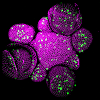A vision of creating crops that do not need chemical fertilisers is one step closer thanks to the recent discovery that a substantial overlap exists in the developmental programmes plants use for lateral roots and nitrogen-fixing nodules.

The ultimate goal of the scientists is to transfer nitrogen fixation into cereals. This aim will benefit those people who have least access to food, particularly smallholder farmers in sub-Sahara Africa, by giving them improved yields of food crops under low-cost and low-input farming systems.
This latest discovery builds on the scientists’ work deciphering the symbiotic communications occurring between plants and bacteria when they form a beneficial nitrogen-fixing relationship, best known in legumes like peas and beans.
Joint lead author of the research, published in Current Biology, Dr Katharina Schiessl, who is a Research Associate in Professor Giles Oldroyd’s team at Cambridge’s Sainsbury Laboratory (SLCU), said the discovery meant that a suite of complex steps needed to grow nodules were already present in all plants: “There’s been a long-standing theory that lateral roots and nodules share some of their developmental steps, but it has never been proven until now,” Dr Schiessl said. “At the very beginning of their formation lateral roots and nodules are developing from the same inner tissue layers and look almost identical – in fact you cannot tell them apart unless you can see the bacteria infecting the roots.”

“Using microscopic imaging and gene expression analysis we were able to track in detail what was happening as new cells began developing and how hormones were coming into play at the very early stages of lateral root and nodule formation. We found that plants that form nitrogen-fixing nodules have adopted the same programme used to grow lateral roots, which evolved many millions of years before nodulation evolved, instead of evolving a completely new programme. This is really exciting as it means that a substantial part of the machinery needed to form nodules is already present in non-nodulating plants.”
The team showed that the lateral root and nodule development converge on the accumulation of the plant hormone auxin that is important in both lateral root and nodule formation. However, the means by which auxin is activated is very different in the initiation of a nodule that promotes auxin accumulation via second plant hormone called cytokinin.
Professor Oldroyd said that cytokinin signalling in conjunction with a key protein known to be acting as a master regulator, called NIN, were controlling this initiation of nodules: “Auxin is being synthesised through cytokinin induction of local auxin biosynthesis and this is controlled by NIN. We know that NIN is required throughout the process of nodule formation and is involved in the interaction between the bacteria and the plant. This research tells us what NIN is doing in legumes that allows the formation of nodules via activation of lateral root organogenesis. NIN is not needed for lateral root development, but it is specifically needed for nodule development. Therefore to engineer nodulation in other plants, we believe we need only to focus on the mode by which the process is induced, i.e. NIN, as opposed to needing to engineer the entire nodule developmental programme. Yet again our research is telling us that many of the processes involved in nodulation are not novel and this makes us optimistic about being able to engineer nitrogen fixation into other crops.”
The next challenge is to use this knowledge to engineer nodules in the cereal crops that provide the majority of human nutrition.
This research was undertaken as a collaboration between scientists from the University of Cambridge, John Innes Centre, Wageningen University and Research, Earlham Institute and Noble Research Institute.
Reference
Katharina Schiessl, Jodi L.S. Lilley, Tak Lee, Ioannis Tamvakis, Wouter Kohlen, Paul C. Bailey, Aaron Thomas, Jakub Luptak, Karunakaran Ramakrishnan, Matthew D. Carpenter, Kirankumar S. Mysore, Jiangqi Wen, Sebastian Ahnert, Veronica A. Grieneisen and Giles E.D Oldroyd (2019) NODULE INCEPTION recruits the lateral root developmental program for symbiotic nodule organogenesis in Medicago truncatula. Current Biology
DOI: 10.1016/j.cub.2019.09.005
Funding
This work was supported by the research project Engineering Nitrogen Symbiosis for Africa (ENSA), which is funded by the Bill & Melinda Gates Foundation (OPP1028264), the Biotechnology and Biological Sciences Research Council (BB/K003712/1), the Gatsby Charitable Foundation (GAT3395/GLH), the NWO 9VENI863-15-010), the National Science Foundation, USA (DBI 0703285 & IOS-1127155) and the Noble Research Institute, LLC.





